![]()
![]()
![]()
Use LEFT and RIGHT arrow keys to navigate between flashcards;
Use UP and DOWN arrow keys to flip the card;
H to show hint;
A reads text to speech;
184 Cards in this Set
- Front
- Back

147-1: Odors in overdose history |

|
|

147-3: ED Antidotes
|

|
|
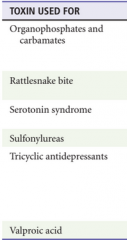
147-3: ED Antidotes (2) |

|
|
|
How does NAC work as an antidote for acetaminophen? |

|
|
|
148-1: Stages of acetaminophen toxicity |

|
|
|
148-2: Indications to initiate testing for serum acetaminophen concentration and AST in chronic acetaminophen ingestion |

|
|
|
148-3: Side effect prfile for NAC formulations (IV vs PO) |
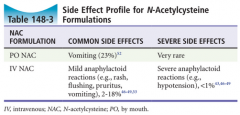
|
|
|
148-4: Significant predictors of the severety of ingestion in Acetaminophen toxicity |

|
|
|
149-1: Symptoms of salicylate toxicity |

|
|
|
149-2: Treatment of acute salicylate poisoning |

|
|
|
Acetylcholine receptor location and function |
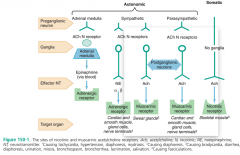
|
|
|
150-1 Drugs exhibiting primarily anticholinergic toxicity |
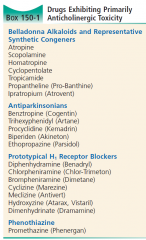
|
|
|
151-2 The Hunter criteria for Serotonin Syndrome |

|
|
|
152-1 Dysrhythmias associated with Digoxin toxicity |
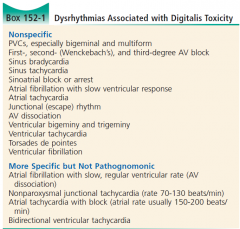
|
|
|
152-2 Factors associated with increased risk of digitalis toxicity |

|
|
|
152-3 Noncardiac symptoms of digitalis intoxication |

|
|
|
Chronic versus acute digoxin toxicity |

|
|
|
152-4 Recommendations for administration of digoxin antibody fragments (adults and children) |

|
|
|
Age differences (adults vs peds) in digitalis toxicity |

|
|
|
152-8 Manifestations and complications of beta blocker overdose |

|
|
|
152-9 Treatment of beta blocker poisoning |

|
|
|
152-10 Manifestations of CCB poisoning |

|
|
|
152-11 Treatment of CCB Intoxication |

|
|
|
154-3 Initial evaluation of patients iwth sympathetic stimulation |

|
|
|
154-4 Management of stimulant induced hyperthermia |

|
|
|
154-5 Causes of stimulant-induced chest pain |

|
|
|
154-6 Admission criteria for cocaine-related chest pain |
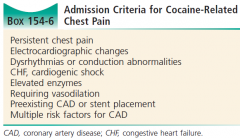
|
|
|
Serum lead levels and toxicity |

|
|
|
Chelators and their indications |
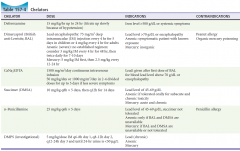
|
|
|
157-1 Acute effects of arsenic poisoning |

|
|
|
161-2 Diagnostic Criteria and clinical features of NMS |
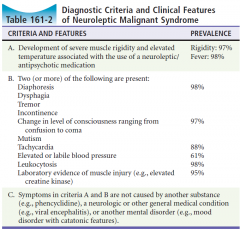
|
|
|
161-3 Differential diagnosis for NMS |

|
|
|
163 Describe the effect of cholinergic drugs on the nervous system |

|
|
|
165-2 Indications and contraindications for the use of Flumazenil |
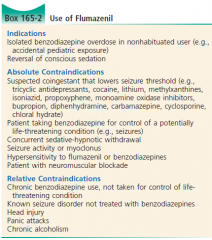
|
|
|
139-1 Freezing injury cascade |

|
|
|
139-2 Predisposing factors for freezing injury |

|
|
|
139-3 Rewarming protocol for frostbite |

|
|
|
139-4 Sequelae of Frostbite |

|
|
|
140 Physiologic characteristics of mild, moderate and severe hypothermia |
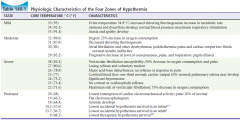
|
|
|
140.3 Indications for active rewarming |

|
|
|
140-1 Factors that predispose hypothermia |

|
|
|
140-2 Presentations of hypothrmia |

|
|
|
141-2 Diagnosis of heat cramps |

|
|
|
141-3 Diagnosis of heat exhaustion |

|
|
|
141-4 Treatment of heat exhaustion |

|
|
|
141-5 Diagnosis of heat stroke |

|
|
|
141-7 Cooling modalities used in heat stroke |

|
|
|
141f Physiology of heat illness |

|
|
|
141t Exertional versus Classic heat stroke |
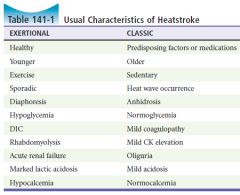
|
|
|
142-1 Electrothermal heating formulas |

|
|
|
142-2 Factors determining extent of electrical injury |

|
|
|
142-3 Resistance of body tissues to electricity |

|
|
|
142-5 Indications for electrocardiographic monitoring following electrical injury |

|
|
|
143-2 Diving disorders that require recompression therapy |

|
|
|
143-3 Diving disorders that do NOT require recompression therapy |

|
|
|
143f Approach to diving diseases |

|
|
|
143t1 Laws of physics for hyperbaric medicine |
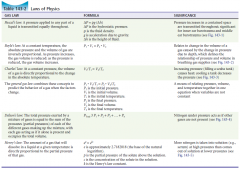
|
|
|
143t2 Contrasting inner ear barotrauma, middle ear barotrauma, and alternobaric vertigo |

|
|
|
143t3 Contrasting decompression sickness and arterial gas embolism |

|
|
|
144f Physiology of high altitude illness |

|
|
|
144t1 Risk categories for acute mountain sickness |

|
|
|
144t2 Risks associated with travel to altitude |

|
|
|
146t1 Radiation exposure prognosis acccording to 48 hour lymphocyte count |

|
|
|
146t2 Medications that can decontaminate radioactive isotopes |

|
|
|
59-1 Risk factors for wound infection |
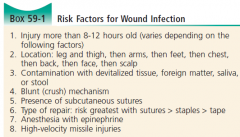
|
|
|
59-2 Wound care instructions |

|
|
|
60t Risk factors for bite wound infection |

|
|
|
61-2 Indications for admission with a human bite to the hand |

|
|
|
62f1 Venomous vs non-venomous snake characteristics |

|
|
|
62f2 Approach to pit viper bite |

|
|
|
62t Antivenin dosing for pit viper envenomation |

|
|
|
63t1 Burn depth classification |

|
|
|
63t2 Burn severity classification |

|
|
|
63t3 indications for intubation in burn patients |

|
|
|
64t Gases that can be used as weapons |

|
|
|
36f1 Patients that must be transferred to a trauma center |

GCS <14 SBP <90 RR <10 or >29
|
|
|
36f1 Patients that must be transferred to a lower level trauma center |

|
|
|
36f1 Patients that must be transferred to specialty care (not necessarily a trauma center) in consultation with medical control. |

|
|
|
36f2 Indications for thoracotomy in penetrating trauma |

|
|
|
36f3 Indications for thoracotomy in blunt trauma |

|
|
|
37f Indications for perimortem C-section |

Translation: Fundus below umbilicus - take care of mom
If above umbilicus and: -Mom arrests with +FHR = C-Section -Mom stable with unstable FHR = consider C-Section |
|
|
38.1 Anatomic differences in children that are important in trauma |

|
|
|
38.2 Equipment size estimates for pediatric trauma |

|
|
|
38.8 Common signs and symptoms of increased ICP in children |

|
|
|
38.9 Common signs and symptoms of increased ICP in children |

|
|
|
38.10 Anatomic differences in the pediatric C-spine |

|
|
|
38.11 Indications for laparotomy in pediatric trauma |

|
|
|
38t1 Anatomic differences in the pediatric airway |

|
|
|
38t2 Pediatric GCS |
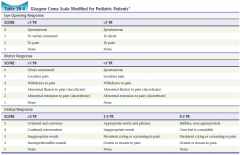
|
|
|
39 Describe and give an example of Haddon`s matrix |

|
|
|
41.2 Indications for seizure prophylaxis after head injury |

|
|
|
41t Return to play protocol after concussions |

|
|
|
Classification of spinal injuries |

|
|
|
Spinal motor exam |

|
|
|
Spinal reflex exam |

|
|
|
Spinal sensory exam |

|
|
|
Soft and hard signs of penetrating neck trauma |

|
|
|
Indications for tube thoracostomy |

|
|
|
Indications for OR thoracotomy |

|
|
|
Indications for ED thoracotomy |

|
|
|
Causes of esophageal perforation |

|
|
|
Clinical indications for laparotomy in penetrating trauma |

|
|
|
Clinical indications for laparotomy in blunt trauma |

|
|
|
Blast injury phases |
1 (blast wave) - ruptured TM, PTx contusion, bowel rupture 2 (hit with shrapnel) - penetrating trauma 3 (become shrapnel and hit stuff) - blunt trauma 4 (radiation, burn, psychiatric fallout) |
|

|
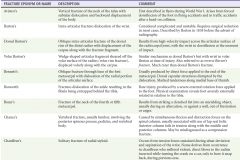
|
|

|

|
|

|

|
|

|

|
|
|
Fracture description |

|
|
|
Open fracture grades |

|
|
|
Management of open fractures |

|
|

|

|
|
|
Diagnostic criteria for complex regional pain syndrome type 1 (type 2 is this with peripheral nerve injury) |

|
|
|
Complications of fractures and immobility |

|
|
|
Life or limb threatening fractures |

|
|
|
Causes of compartment syndrome |

|
|
|
Anatomic locations of compartment syndrome |

|
|
|
Bones at risk of avascular necrosis |
-Scaphoid -Lunate -Capitate -Femoral head -Talus |
|
|
Normal pediatric vital signs |

|
|
|
Pediatric assessment triangle and findings |

|
|
|
Historical features of child abuse |

|
|
|
PE and x-ray findings of child abuse |

|
|
|
Rochester Criteria |

|
|
|
Febrile infant algorithm |

|
|
|
CDC definition of toxic shock syndrome |

|
|
|
Duke major criteria for endocarditis |

|
|
|
Duke minor criteria for endocarditis |

|
|
|
Location and cause of stridor |

|
|
|
Indications for the admission of croup |

|
|
|
Contrast croup, bacterial tracheitis, and epiglottitis |

|
|
|
Bronchiolitis assessment tool |

|
|
|
Noninfectious pneumonia mimics |

|
|
|
Signs and symptoms of cardiac lesions in children |
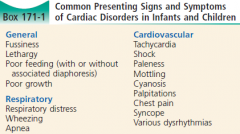
|
|
|
Causes of decreased stroke volume in infants and children |
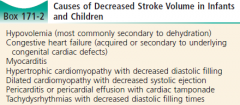
|
|
|
Normal fetal circulation |
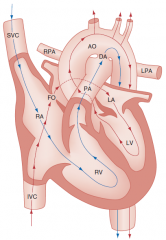
|
|
|
Cardiac versus respiratory cyanosis |
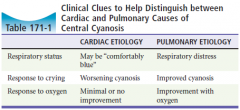
|
|
|
Concerning cardiac murmurs |

|
|
|
Time of presentation of congenital cardiac defects |
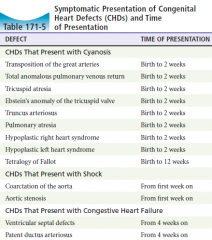
|
|
|
Ductal dependent cardiac lesions |
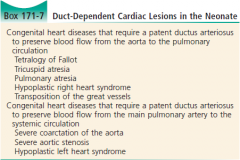
|
|
|
Prostaglandin infusion rate |

|
|
|
Acyanotic congenital heart disease diagnostic algorithm |

|
|
|
Cyanotic congenital heart disease diagnostic algorithm |
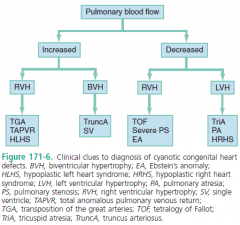
|
|
|
Hypoxic tet spell pathophysiology |

|
|
|
Management of a hypoxic tet spell |

|
|
|
Recommendations for palivizumab in congenital heart disease |

|
|
|
Distinguishing SVT from VT |

|
|
|
Clinical scenarios suspicious for endocarditis in cardiac kids |

|
|
|
Cardiac lesions in which endocarditis prophylaxis is reasonable |

|
|
|
Cardiac lesions in which endocarditis prophylaxis is recommended |

|
|
|
Diagnostic criteria for Kawasaki disease |
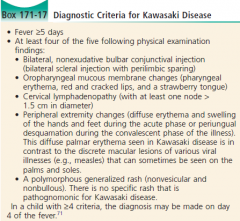
|
|
|
Jones criteria for rheumatic fever |

|
|
|
Causes of cardiovascular death in young athletes |

|
|
|
Supplemental laboratory criteria for Kawasaki disease |

|
|
|
Infant hyperbilirubinemia |

|
|
|
Hyperbilirubinemia in older children |

|
|
|
Indications for jaundice workup in infants |

|
|
|
Emesis differential by age |

|
|
|
Abdominal pain differential by age |

|
|
|
GIB differential by age |

|
|
|
Pancreatitis differential in children |
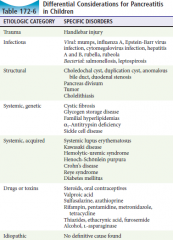
|
|
|
Common causes of emesis in children |

|
|
|
Common causes of diarrhea in children |

|
|
|
Common causes of infectious diarrhea |

|
|
|
Diarrhea in children requiring medical workup |
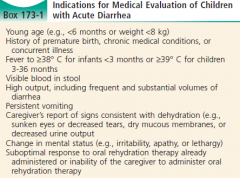
|
|
|
Clinical assessment of dehydration |

|
|
|
Differential for dysuria in children |

|
|
|
Differential for hematuria in children |

|
|
|
Differential for acute renal failure in children |

|
|
|
Differential for hypertension in children |

|
|
|
Pediatric medications for hypertensive emergencies |

|
|
|
Findings of bacterial meningitis in infants and children |

|
|
|
Indications for LP in suspected bacterial meningitis |

|
|
|
Differential diagnosis of acute bacterial meningitis |

|
|
|
Empiric treatment of bacterial meningitis in children |
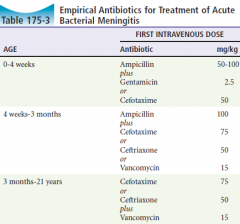
|
|
|
Causes of neonatal seizures |

|
|
|
Seizure mimics in children |

|
|
|
Drugs that can cause seizures |

|
|
|
Differential for headaches in children |

|
|
|
Criteria for diagnosing a migraine in a child |
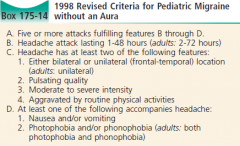
|
|
|
Indications for imaging in children with seizures |

|
|
|
Differential for ataxia in children |

|
|
|
Vertigo evaluation in children |
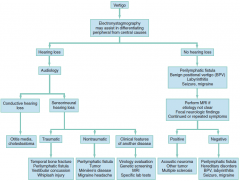
|
|
|
Differential diagnosis of vertigo in children |
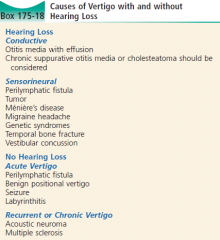
|
|
|
|
|

